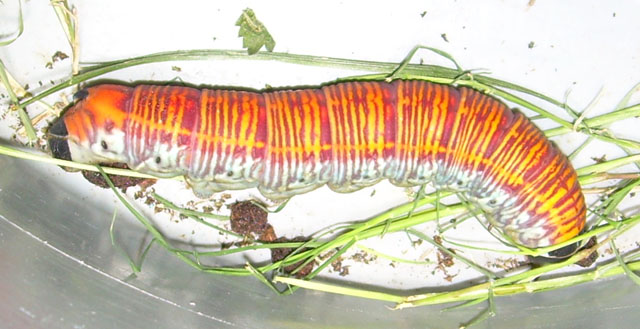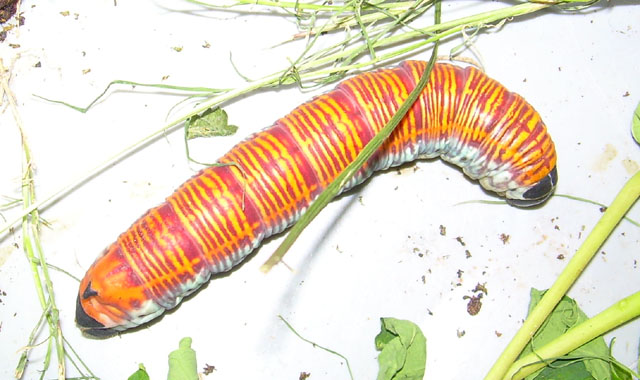Pachylia ficus
Fig Sphinx Caterpillar

Pachylia ficus caterpillar courtesy of Beatrice Cruz
and students,
elementary school science lab in Harlingen, Texas.

Pachylia ficus caterpillar courtesy of Beatrice Cruz
and students,
elementary school science lab in Harlingen, Texas.
On October 17, 2007 Breatrice writes,
"Dear Bill:
"My name is Beatrice and I teach at an elementary in Deep South
Texas, Harlingen, Texas. We have a science lab and I run the lab. We
started this lab last year and it has become something very exciting
on campus. Ever since I started running the lab, students have been
bringing me all kinds of bugs and small creatures.
"Iíve made a huge bulletin board of various butterflies and moths
that I have found or that other teachers and students have brought
me. (Iíve enclosed those pictures).
"I try to research about the butterfly or moth and find a picture of
the caterpillar that it used to be. The students really enjoy
bringing me new animals.
"The reason I am writing is because I had a student bring the biggest
orange caterpillar I have ever seen in my life. (Iíve also enclosed
pictures.) Itís about 4Ē long.
"I finally came across your website and found out that it is a Ficus
Sphinx. Iím so excited to be able to report tomorrow what it is. My
question is now how can I create an ďenvironmentĒ where the students
can watch this caterpillar morph into a moth. This would be such a
wonderful experience if I could get it to happen.
"Please let me know what I can do and any additional information
about this creature. Thank you so much for all the work you are
already doing."
***
I very much appreciate Beatrice's efforts to make the lab come alive
for her students. I am sure there are things they will see and learn
that will remain with them for the rest of their lives.
Most images of Sphingidae larvae (caterpillars) that I receive are
of mature caterpillars that are ready to pupate.
The larvae are quite noticeable at that time due to their
relatively large size, or due to their situation: 1) they might be
near the end of a plant twig where they have just devoured five or six
leaves, rendering them quite visible, or 2) they may have left the
plant and are crawling around on the ground, seeking some soft earth
so that they can excavate a subterranean chamber in which to pupate.
Birds love to eat caterpillars, and the avians probably find a great
many meals at this time in a caterpillar's life.
To rescue the caterpillar from a possible trip down a bird's gullet
and watch it transform first into a pupa and then into a moth or
butterfly, there are a few simple but important steps to follow.
1) Handle the caterpillar as little as possible. Most caterpillars,
especially those of the Sphingidae, are completely harmless to humans,
but there are some spiny or even hairy ones from other families
that can sting or cause an allergenic reaction. It is best to pick
the caterpillar up with its feet and your fingers firmly attached
to a twig. If that
is not possible, then allowing it to crawl onto a piece of paper or twig
or into a jar or cup is prefered.
2) Have a look at the immediate surroundings and take note of the
foodplant(s) the caterpillar has been eating or might have been
eating. If the caterpillar was found on a branch or stem and it is
still feeding and growing, them some leaves, still affixed to the stem
should be brought into the lab with the caterpillar. Many caterpillars
will only eat specific plants.
3) A good habitat for rearing and observing is a nice sized glass
jar (quart or litre sized or bigger), or a clear plastic tub,
aquarium, etc.
Caterpillars require very little air, but they do need to take in
moisture from their food. For that reason it is best to rear them
and watch them develop in an airtight container. They will not suffer
from lack of air and the closed environment will conserve the moisture
content of the foliage (leaves) they might continue to eat.
Many people try to rear the caterpillars in a jar with a cloth or
screen top, or the people punch holes in the jar lid. Sometimes this
works, but it is not necessary, and it can actually be detrimental
to the caterpillar if the leaves lose too much moisture.
4) The rearing container should be cleaned out at least every
other day and fresh leaves should be offered so that
developing caterpillars are never without food. Again, handle
the caterpillars as little as possible. You can carefully empty
the contents of the jar onto a piece of newspaper on a counter
or desk top, then thoroughly clean out the jar and dry the insides
of the jar, if it has been washed. Put in some fresh leaves,
still affixed to the twig and carefully put the caterpillar back
into the jar, preferably still attached to a leaf or stem. The
caterpillar will crawl onto the fresh food soon enough.
5) The Sphingidae caterpillars do not spin silken cocoons when
they are mature. Instead, most of them will leave the host plant
and will crawl on the ground and seek some soft earth in which
to dig an earthworm-like hole. Sometimes they dig down to
a depth of six inches, squirm around and compact the soft earth so
that they have a nice comfortable chamber in which to pupate. Often,
however, they will pupate amongst leaf litter on the surface or
excavate a much more shallow tunnel/chamber.
6) You can watch what typically goes on under the earth by placing
the mature caterpillar in an antfarm-like structure, i.e., two
pieces of upright glass in a frame sandwiching some loose soil. It
is much easier, however, just to place the mature caterpillar in a
tub, jar, bucket, etc., with a paper towel loosely folded and placed
on the bottom of the container.
7) You can tell when the caterpillar is mature by its behaviour.
When it stops feeding, leaves the foliage and crawls around the
bottom of container, it is looking for a safe haven, and that is the
time to move it to the housing described above.
8) The caterpillar will usually crawl under the paper towel, give off
considerable moisture, and shrink noticeably. Its legs will become
quite stumpy after a couple of days, and it will no longer be able to
crawl.
9) Usually within four or five days, the caterpillar will shed its
skin and form a pupa. In mid summer the pupa stage usually only lasts two
to three weeks before the adult moth will emerge. Caterpillars found in
the fall, however, will usually remain in a dormant stage, called diapause,
over the winter months.
To be continued, when you write back and tell me you now have a pupa.
Email: Bill Oehlke
Use your browser "back" button to return to the previous page.

